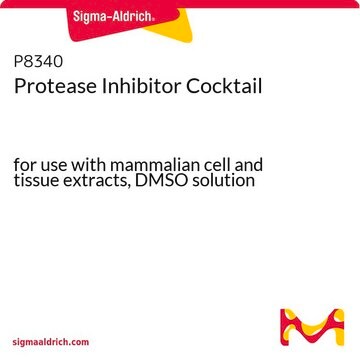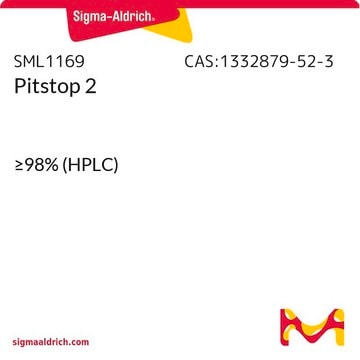Yes, this material has a fluorescence spectrum similar to DAPI, with excitation at 340-380 nm and emission at 385-470 nm. The images displayed above were acquired using UV filter set (340-380 nm excitation, 40 nm dichroic, 430-nm long pass filter). Please note that Filipin fluorescent staining photo-bleaches very rapidly, thus the sample should be analyzed immediately.
SAE0087
Filipin III ready made solution
from Streptomyces filipinensis, 1mg/ml in DMSO based solution
Synonym(s):
Filipin III solution
About This Item
Recommended Products
Quality Level
Assay
≥95% (HPLC)
form
ready-to-use solution
storage condition
protect from light
shipped in
dry ice
storage temp.
−20°C
Related Categories
General description
used as a probe for sterol location in biological membranes 2 and has been used clinically as a stain for free cholesterol in the study of Type C Niemann-Pick disease. 3 Filipin inhibits prion protein (PrP) endocytosis and causes the release of PrP from the plasma membrane. 4 Filipin III was found to trigger signaling responses in tobacco cells, including a NADPH oxidase-dependent production. 5. The antifungal mechanism of action may be due to altering membrane permeability and associated functions by binding to membrane sterols. Filipin inhibits prion protein (PrP) endocytosis and causes the release of PrP from the plasma membrane.
Application
Other Notes
- Filipin III solution is very sensitive to air and light. Upon receipt aliquot and store at -20°C avoid freeze thaw cycles.
- Filipin III is used in various concentrations depending on the specific protocol used. Dilute 1mg/ml stock solution with appropriate buffer according to the used protocol.
- Filipin III interaction with cholesterol alters the absorption and fluorescence spectra, for visualization with a fluorescence microscope use excitation at 340-380 nm and emission at 385-470 nm (Filipin fluorescent staining photo-bleaches very rapidly, thus the sample should be analyzed immediately).
Storage Class Code
10 - Combustible liquids
WGK
WGK 1
Flash Point(F)
188.6 °F
Flash Point(C)
87 °C
Choose from one of the most recent versions:
Certificates of Analysis (COA)
Don't see the Right Version?
If you require a particular version, you can look up a specific certificate by the Lot or Batch number.
Already Own This Product?
Find documentation for the products that you have recently purchased in the Document Library.
Customers Also Viewed
-
Would it be possible to image this product using a DAPI filter (Excitation 377 nm, Emission 447 nm)?
1 answer-
Helpful?
-
-
Any suggestions for addressing white precipitations observed during Filipin staining for endothelial cells, possibly due to DMSO? Also, seeking advice to improve the experiment where most cells were negative for Filipin staining, and only a few were positive while measuring cholesterol content in HUVEC cells.
1 answer-
To address white precipitations observed during Filipin staining for endothelial cells, increasing the amount of DMSO in the final staining solution may be necessary. This can be achieved by diluting the 1 mg/ml Filipin III solution with more DMSO solution to create a 0.5 mg/ml or 0.1 mg/ml concentrated solution prior to staining the samples.
For improving cholesterol content measurement in HUVEC cells, optimize the working concentration of Filipin and conduct a time-course experiment to enhance staining results. Prompt analysis of stained samples can help prevent photobleaching.Helpful?
-
Active Filters
Our team of scientists has experience in all areas of research including Life Science, Material Science, Chemical Synthesis, Chromatography, Analytical and many others.
Contact Technical Service















